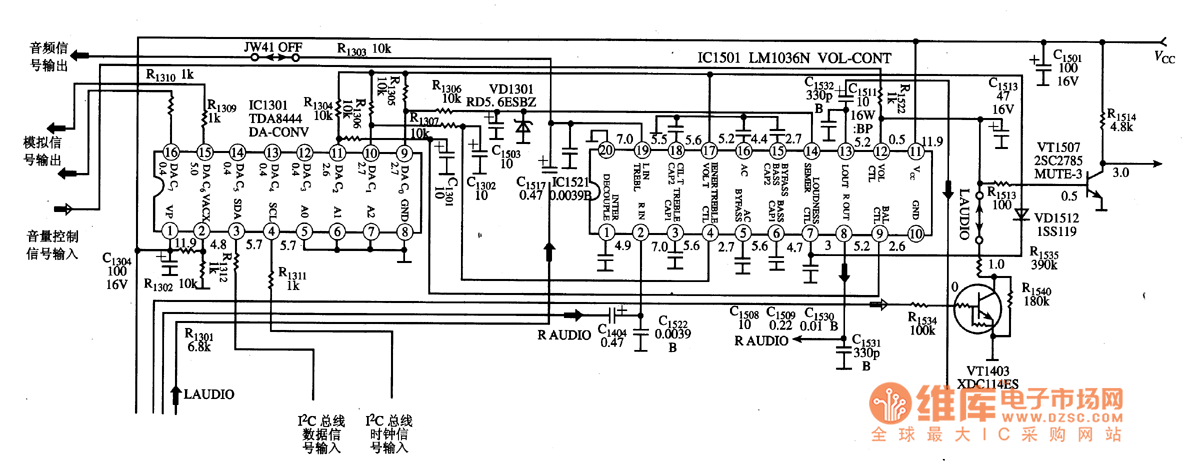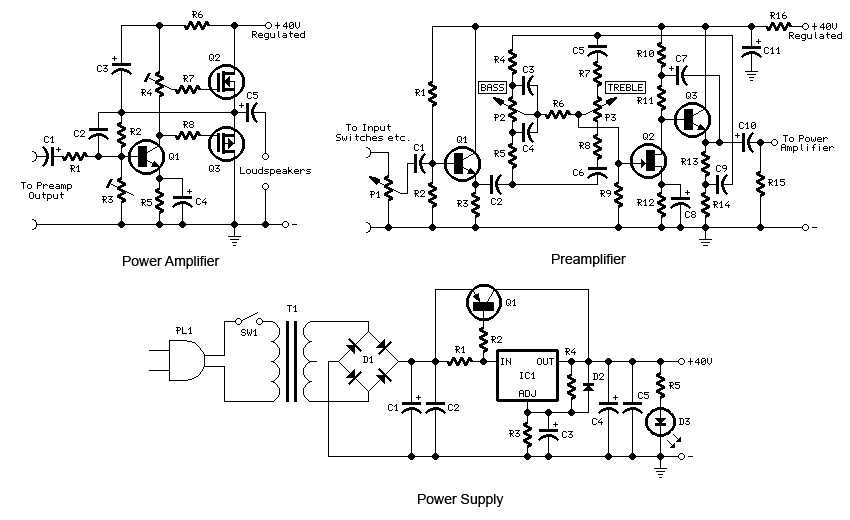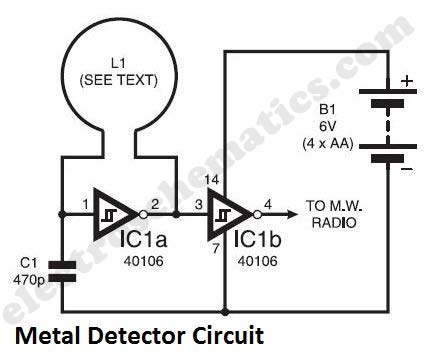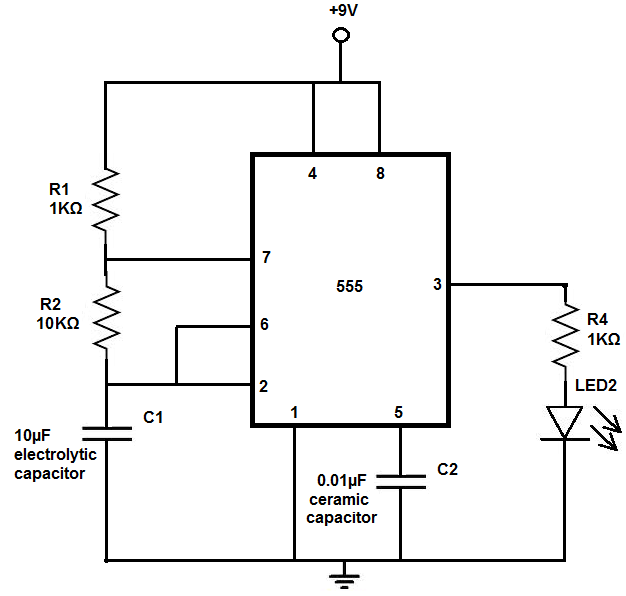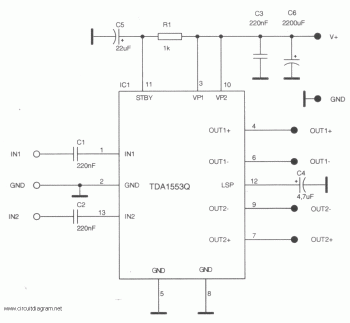
audio graphic equalizer circuit

This design circuit is for audio graphic equalizers, which are commonly found as commercial products, yet published circuits for them are quite rare. The circuit features a simple design that requires an operational amplifier (op-amp) to amplify the input signal. Only one gyrator stage is depicted, although all seven gyrators are identical. The circuit's configuration varies only in the capacitors, as illustrated in the accompanying chart. Three of the seven faders are shown to indicate their placement within the circuit. A gyrator is a circuit that utilizes active devices and transistors to simulate an inductor. In this design, the gyrator is formed by a transistor interacting with resistors R1 and R3, along with capacitor C2. A unity gain op-amp could alternatively serve this function. The circuit includes three formulas: the first determines the center frequency of the band (f), the second relates the quality factor (Q) to the capacitor ratio, and the third calculates the impedance presented by the circuit. This impedance comprises three terms: the first is purely resistive, the second represents the capacitive contribution from capacitor C1, and the third is an inductive term derived from the gyrator.
The audio graphic equalizer circuit operates by dividing the audio frequency spectrum into multiple bands, each of which can be independently adjusted to enhance or attenuate specific frequencies. The use of gyrators in this design allows for the simulation of inductive behavior without the need for physical inductors, thus contributing to a more compact and cost-effective circuit.
Each gyrator stage is configured to respond to a specific frequency range, with the faders providing user control over the gain for each band. The operational amplifier plays a critical role in ensuring that the input audio signal is amplified sufficiently to drive the gyrators, which in turn manipulate the signal's frequency response.
The center frequency (f) for each band can be calculated using the provided formula, which takes into account the values of the capacitors and resistors in the circuit. The quality factor (Q) is essential for defining the bandwidth of each filter, with higher Q values resulting in narrower passbands. The relationship between Q and the capacitor ratio is crucial for achieving the desired frequency response characteristics.
The impedance calculation is vital for understanding how the circuit interacts with other components in the audio system. The resistive component ensures stability, while the capacitive and inductive terms allow for the tuning of frequency response. This comprehensive approach to circuit design enables the creation of effective audio graphic equalizers capable of delivering high-quality sound tailored to user preferences.This is a design circuit for audio graphic equalizers, that are very common as commercial products but circuits for them are very rarely published. This circuit is a simple design circuit. The circuit is needs an op-amp for amplifying the input signal. This is the figure of the circuit. Only one gyrator stage is shown: all 7 gyrators are the same circuit, only the capacitors change, as shown in the chart. I have shown three of the seven faders to show where they go. A gyrator is a circuit using active devices and transistors to simulate an inductor. In this case the gyrator is the transistor acting with R1, R3 and C2. It could just as easily be a unity gain op-amp. The circuit includes three formulae: one which gives f, the the centre frequency of the band. The second shows how the Q is related to the capacitor ratio. The third shows the impedance presented by the circuit. Note that this includes 3 terms, the first purely resistive, the second is the capacitive contribution from C1 and the third is an inductive term from the gyrator. 🔗 External reference
The audio graphic equalizer circuit operates by dividing the audio frequency spectrum into multiple bands, each of which can be independently adjusted to enhance or attenuate specific frequencies. The use of gyrators in this design allows for the simulation of inductive behavior without the need for physical inductors, thus contributing to a more compact and cost-effective circuit.
Each gyrator stage is configured to respond to a specific frequency range, with the faders providing user control over the gain for each band. The operational amplifier plays a critical role in ensuring that the input audio signal is amplified sufficiently to drive the gyrators, which in turn manipulate the signal's frequency response.
The center frequency (f) for each band can be calculated using the provided formula, which takes into account the values of the capacitors and resistors in the circuit. The quality factor (Q) is essential for defining the bandwidth of each filter, with higher Q values resulting in narrower passbands. The relationship between Q and the capacitor ratio is crucial for achieving the desired frequency response characteristics.
The impedance calculation is vital for understanding how the circuit interacts with other components in the audio system. The resistive component ensures stability, while the capacitive and inductive terms allow for the tuning of frequency response. This comprehensive approach to circuit design enables the creation of effective audio graphic equalizers capable of delivering high-quality sound tailored to user preferences.This is a design circuit for audio graphic equalizers, that are very common as commercial products but circuits for them are very rarely published. This circuit is a simple design circuit. The circuit is needs an op-amp for amplifying the input signal. This is the figure of the circuit. Only one gyrator stage is shown: all 7 gyrators are the same circuit, only the capacitors change, as shown in the chart. I have shown three of the seven faders to show where they go. A gyrator is a circuit using active devices and transistors to simulate an inductor. In this case the gyrator is the transistor acting with R1, R3 and C2. It could just as easily be a unity gain op-amp. The circuit includes three formulae: one which gives f, the the centre frequency of the band. The second shows how the Q is related to the capacitor ratio. The third shows the impedance presented by the circuit. Note that this includes 3 terms, the first purely resistive, the second is the capacitive contribution from C1 and the third is an inductive term from the gyrator. 🔗 External reference
